Mastering the Art of Painting Vinyl Siding
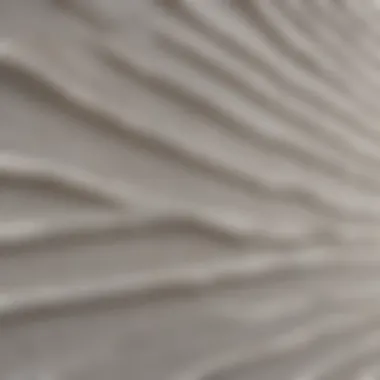
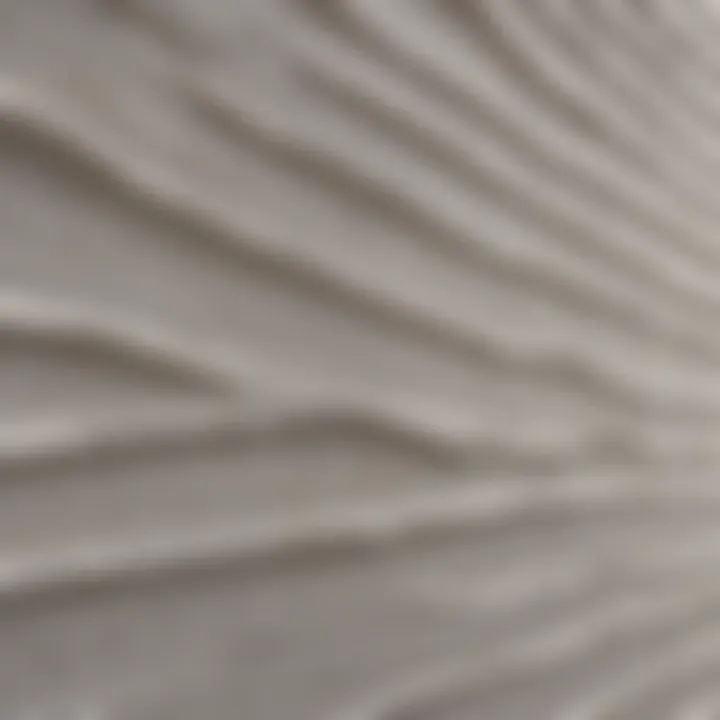
Intro
In recent years, painting vinyl siding has garnered significant attention. Homeowners are exploring how this can improve the aesthetic appeal of their houses. Often, there are numerous misconceptions around this subject. Misunderstanding can lead to improper techniques or unsuitable materials. Therefore, a detailed exploration is essential. Let's uncover the truth about painting vinyl siding, addressing preparation, materials, techniques, and maintenance.
Design Inspirations
When considering a painted vinyl siding project, design inspirations serve as the foundation to achieve the desired outcome. Choosing the right look comes down to trending styles and selective color palettes.
Trending Styles
Several design trends influence homeowners today. One popular approach is the modern farmhouse style. This style emphasizes a rustic yet sophisticated look. It incorporates neutral shades combined with bolder accents.
Another trend is minimalism, focusing on clean lines and simplicity. Neutral tones and soft pastels characterize this aesthetic. For a bolder statement, eco-technology styles blend natural shades with vivid hues. This includes deep greens and rich blues, reflecting a connection to nature.
Color Palettes
Choosing the right colors enhances the beauty of the home while reflecting the owner's taste. Here are some popular color combinations:
- Cool tones like slate gray or soft blue paired with crisp white.
- Warm tones such as terracotta combined with cream.
- Bold contrasts like charcoal and gold for a sophisticated touch.
Selecting a color palette that integrates with the existing surroundings can create harmony in one's landscape. This connection is vital in realizing an appealing home exterior.
"Color influences our perception of space and can radically transform the appearances of homes."
Maintenance and Upkeep
Once the paint is applied, maintenance becomes crucial to ensure longevity. Proper care prevents deterioration, keeping the exterior looking fresh.
Seasonal Maintenance Checklist
Homeowners should follow a seasonal checklist for maintaining painted vinyl siding. Key tasks include:
- Inspecting the siding for any signs of wear or fading every season.
- Cleaning the surfaces with a gentle detergent annually.
- Checking for mold or mildew growth to address promptly.
- Caulking seams or joints to prevent moisture intrusion.
Cleaning and Organization Tips
Effective cleaning practices protect the painted vinyl surface. Use soft brushes and avoid abrasive materials for scrubbing. Warm water and mild soap are ideal for removing dirt and grime.
Regular organization of gardening tools and outdoor furniture can prevent unnecessary scratches or damage to the siding. Keeping the vicinity clean adds to the overall look of a home, ensuring the painted vinyl resides in a neat environment.
Prelims to Vinyl Siding
Vinyl siding has become a popular choice among homeowners due to its resilience, low maintenance needs, and aesthetic versatility. It is essential to understand the nuances surrounding this material, especially for those considering painting it. This section delves into what vinyl siding is, the advantages it offers, and the common concerns homeowners may raise when contemplating a change in its appearance.
What is Vinyl Siding?
Vinyl siding is a type of exterior cladding made from polyvinyl chloride (PVC) resin. This material is designed to mimic the appearance of wood siding while providing various benefits. It comes in a spectrum of colors and styles, allowing for customization that suits individual preferences and architectural designs.
The manufacturing process involves extruding and coloring the vinyl, which results in durable planks that can withstand various weather conditions. Unlike wood, vinyl does not rot, warp, or require regular painting, making it an appealing option for many homeowners. Its installation also tends to be quicker and more straightforward compared to traditional siding materials.
Benefits of Vinyl Siding
The advantages of vinyl siding extend beyond its visual appeal. Noteworthy benefits include:
- Cost-Effectiveness: Vinyl siding is often more affordable than materials such as wood or brick.
- Low Maintenance: Homeowners appreciate that vinyl siding requires minimal upkeep. It only needs periodic washing to maintain its appearance.
- Energy Efficiency: Many vinyl siding products are designed with insulation, enhancing a home’s energy efficiency, which can lead to lower utility bills.
- Durability: Vinyl is well known for its resistance to fading, cracking, and splitting. This helps maintain its look over time, reducing the need for replacements.
- Wide Range of Options: With numerous styles and colors, homeowners can easily find the perfect look for their homes.
Common Concerns Regarding Painting
While vinyl siding offers undeniable benefits, there are some apprehensions regarding its paintability. Many homeowners express concerns about how well paint adheres to vinyl. Painting must be done correctly to avoid issues like peeling or fading.
Another concern is related to the potential for voiding warranties. Certain manufacturers may have specific guidelines regarding alterations to their products. Thus, always check warranty stipulations before proceeding with painting.
Additionally, color choice is critical. Some lighter colors may reflect sunlight, helping to maintain the integrity of the vinyl, while darker shades can cause the material to absorb more heat, which may lead to warping or other structural issues.
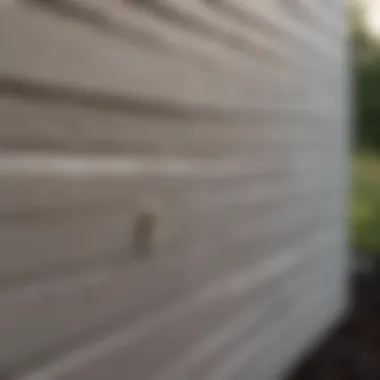
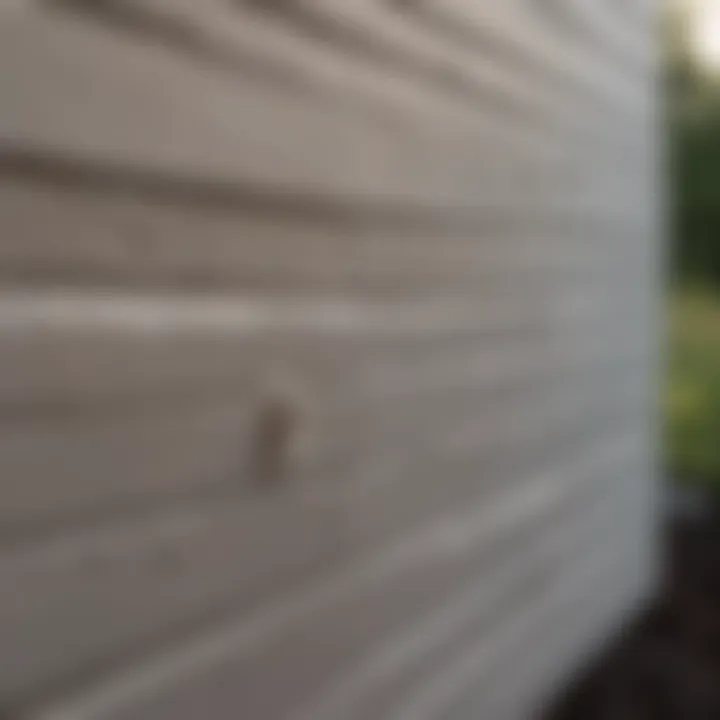
"Understanding the fundamental aspects of vinyl siding prepares homeowners for responsible decision-making regarding painting."
Conclusively, this introduction to vinyl siding sets the stage for a deeper exploration of the painting process and its implications. By understanding the basic properties and advantages of vinyl siding, homeowners can make informed choices that enhance their residence.
Is It Easy to Paint Vinyl Siding?
Painting vinyl siding can often seem like a daunting task for homeowners. Understanding the ease or difficulty of this project is crucial when deciding whether to undertake it yourself or hire a professional. This section delves into the inherent complexities and considerations for painting vinyl. Evaluating the process not only helps in making informed choices but also sets realistic expectations.
Understanding the Difficulty Level
The ease of painting vinyl siding often depends on several factors. The surface of vinyl is designed to be low-maintenance, which can create challenges when applying paint effectively. Vinyl siding is typically made of a flexible material that can expand and contract with temperature changes. This can affect how well paint adheres to the surface.
Moreover, the previous color and the original finish may also complicate matters. Some paints can poorly adhere to glossy surfaces, requiring additional steps like sanding or priming. Therefore, while some homeowners successfully paint their vinyl siding, the process requires careful planning and attention to detail.
Factors Influencing Ease of Painting
Several factors play a significant role in how easy it is to paint vinyl siding. Here are some key elements to consider:
- Weather Conditions: Ideal temperature and humidity levels promote better adhesion. Painting on an excessively hot or cold day can lead to problems.
- Type of Paint: The choice of paint is essential. Not all paints are suitable for vinyl, and using the wrong type can lead to peeling or fading.
- Preparation Work: Proper preparation, such as cleaning and repairing the siding, can ease the painting process. Skipping these may result in an uneven finish or paint failure.
- Technique: The method of application, whether spraying, rolling, or brushing, influences the overall success. Some techniques may be better suited for vinyl siding than others.
"Preparing for the painting process is often just as important as the actual painting itself."
By understanding these factors, homeowners can better assess the feasibility of painting their vinyl siding and approach the project with informed strategies. Being aware of these details allows for a more manageable, effective, and enjoyable painting experience.
Preparation Before Painting
Preparing vinyl siding for painting is a crucial step that can greatly affect the quality and durability of your finished project. Not only does proper preparation enhance adhesion, but it also helps achieve a smooth and even finish. Skipping this phase may lead to unsatisfactory results, even if the final paint chosen is of high quality.
Before diving into the actual painting, several specific actions need to be taken that require attention to detail and careful consideration. This section will explore these necessary steps in depth.
Cleaning the Surface
The first step in preparation is cleaning the vinyl siding thoroughly. Accumulated dirt, grime, and mildew can prevent paint from adhering properly.
- Choose the Right Cleaning Solution: A mixture of water and mild detergent is often effective. Some people also use specialized vinyl siding cleaners. Always test a small area first to ensure compatibility.
- Use a Soft Brush or Cloth: Avoid abrasive materials that can scratch the surface. Gently scrub the siding, paying close attention to corners and joints where dirt collects.
- Rinse Thoroughly: After scrubbing, rinse with a garden hose or pressure washer on a low setting to remove any cleaning agents. Allow the surface to dry completely.
This step not only ensures a clean surface but also helps in revealing any underlying damages that may need repair.
Inspecting for Damage
Once the siding has been cleaned, it’s time to inspect it for any damage or imperfections. This can include cracks, holes, or warping that could compromise the paint job.
- Look for Cracks or Holes: Small cracks can often be filled with caulk. For larger holes, consider using a patch kit designed for vinyl siding.
- Check for Warping: Warped panels can be inconvenient and may need to be replaced. Make notes of any areas that need attention.
- Assessing Panel Anchors: Ensure panels are properly secured. Loose panels can create issues when the painting process begins.
Conducting a thorough inspection and making necessary repairs can save time and headaches during the painting process.
Removing Any Existing Coatings
If your vinyl siding has been previously painted or coated, it is essential to remove these layers before applying a new coat. Older coatings can lead to poor adhesion and an uneven finish.
- Determine the Type of Existing Coatings: Use a test patch to see if the current paint is water-soluble or requires a different solvent for removal.
- Use Appropriate Tools: Depending on the coating type, you may need scrapers or solvent-based removers. Pay attention to instructions provided with any solvents used.
- Rinse Again: After removal, rinse the surface well to eliminate any leftover residues.
Taking the time to remove unwanted coatings helps ensure that your paint will bond well and last over time.
Choosing the Right Paint
Selecting the appropriate paint for vinyl siding is crucial in ensuring a successful and lasting finish. The right paint can enhance the aesthetic appeal of your home while providing adequate protection against harsh weather elements. It is important to recognize that not all paints are created equal, especially when it comes to vinyl surfaces. Understanding these variables will lead to a better, more satisfying outcome.
Paint formulated for vinyl is typically designed to be flexible and withstand changes in temperature. The importance of choosing the right paint lies not only in appearance but also in the durability of the project. Using subpar materials can result in unwanted peeling, fading, or other failures of the paint, leading to additional troubles down the road.
Types of Paint Suitable for Vinyl
When it comes to painting vinyl siding, there are specific types of paint that one should prioritize. Here are a few notable options:
- Acrylic Paint: This is perhaps the most popular choice among homeowners. Acrylic paint adheres well to vinyl, and it remains flexible even after drying. This flexibility helps to prevent cracking and peeling, especially in varied weather conditions.
- Vinyl Safe Paint: These paints are specially formulated to work with vinyl materials. They offer good adhesion and flexibility. Many brands produce this type specifically to address concerns related to traditional paint on vinyl.
- Top-Coat Coatings: These products are designed to provide an additional layer of protection over painted surfaces. They can be particularly useful in extending the lifespan of the color and finish applied to the siding.
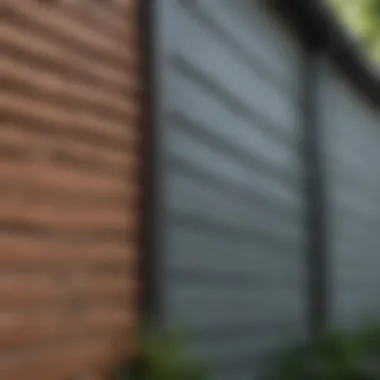

It is essential to check product labels when purchasing paint. Look for terms such as "vinyl safe" or "suitable for vinyl siding" to ensure that the paint will perform well in your project.
Color Considerations for Vinyl Siding
Color selection is another important aspect of painting vinyl siding. Various factors influence your decision, and understanding these can help you achieve the best results.
- Heat Absorption: Dark colors tend to absorb more heat, which could potentially warp the vinyl. It is advisable to choose light or medium-toned colors that reflect sunlight rather than absorb it.
- Neighborhood Guidelines: If you live in a community with specific regulations, check color guidelines. Some homeowners' associations might have rules regarding exterior colors to maintain aesthetic uniformity.
- Personal Preference: Ultimately, your choice should reflect your personal style and the overall design of your home. Neutral tones generally offer versatility, while bold colors can make a striking statement.
"Choosing the right paint color not only affects curb appeal but also impacts the lifespan and performance of your vinyl siding."
Tools and Materials Needed
The choice of tools and materials is crucial when it comes to painting vinyl siding. A well-prepared approach ensures not only a successful finish but also the longevity of the paint job. When engaging in this DIY project, it is essential to select the right tools and materials to achieve a smooth and even application. This section outlines the key tools and materials needed and the reasoning behind their importance.
Essential Painting Tools
Utilizing the correct painting tools is essential for ensuring that the paint adheres properly and looks professional. Here are several key tools to have on hand:
- Paint Sprayer: A paint sprayer provides an even application and can cover large areas quickly, making it an efficient choice for vinyl siding.
- Rollers: For those who prefer a more hands-on approach, using rollers designed for exterior surfaces can yield satisfactory results.
- Brushes: Quality brushes assist in reaching tight corners and edges where other tools may struggle.
- Extension Poles: These allow for easy access to high areas without needing a ladder, which is beneficial for safety.
- Drop Cloths: Protecting the surroundings from splatters and spills is fundamental. Drop cloths help maintain a clean work environment.
Each of these tools plays a significant role in creating a seamless finish. Not only do they affect the final appearance, but they also influence the effort required to complete the project.
Protective Gear and Safety Measures
Safety should always be a priority when painting any surface, including vinyl siding. Using proper protective gear minimizes risks associated with chemical exposure and physical accidents. Here’s a list of recommended safety measures:
- Gloves: Wearing gloves can protect hands from paint and harmful chemicals.
- Respirators: Paint fumes can be hazardous to health. A respirator with appropriate filters will help reduce inhalation of harmful vapors.
- Safety Glasses: Protecting the eyes from splatters is important. Safety glasses will keep eyes safe from potential irritants in the paint.
- Knee Pads: If you anticipate spending long hours on your knees, having knee pads can provide comfort and prevent strain.
Adopting these safety protocols not only ensures personal safety but also helps create a smoother workflow.
"Preparation is key; investing in proper tools and safety equipment can transform a daunting task into a manageable one."
The Painting Process
Understanding The Painting Process is critical in the context of enhancing the aesthetic appeal and longevity of vinyl siding. Proper application of paint requires careful consideration of several components to achieve optimal results. It influences the overall effectiveness of the project, ensures an even finish, and affects how well the paint adheres to the vinyl substrate. Ignoring any step can lead to unsatisfactory outcomes, such as peeling or uneven surfaces, which diminishes the visual appeal.
Applying Primer to Vinyl Siding
Primer serves as an essential base layer when painting vinyl siding. It plays a significant role in promoting adhesion and ensuring that the paint bonds effectively. When selecting a primer for vinyl, it is critical to choose a product specifically designed for this material. Using a compatible primer can help prevent issues like chipping and peeling in the future.
Before applying primer, ensure the surface is clean and dry. This prevents contaminants from interfering with adhesion. Rollers and brushes may be used, but a spray application can provide a smoother finish. Apply the primer evenly, allowing it to dry as per the manufacturer's recommendations before proceeding with the paint.
Techniques for Painting Vinyl Siding
When painting vinyl siding, employing the right techniques can make a significant difference in the outcome. Here are some practical steps to consider:
- Choose the Right Equipment: Select high-quality brushes, rollers, or sprayers that suit your skill level.
- Avoid Direct Sunlight: Painting in direct sunlight can cause the paint to dry too quickly, leading to uneven coverage. Early morning or late afternoon is usually optimal.
- Use Long, Even Strokes: When painting, use long, smooth strokes to ensure even coverage. Overlap each stroke slightly to avoid streaks.
- Consider Multiple Coats: Depending on the color and finish of the paint, applying multiple coats may be necessary for full coverage.
Incorporating these techniques will not only enhance the paint job but also potentially extend the lifespan of the finish.
Drying and Curing Times
Proper drying and curing times are essential in the painting process for vinyl siding. It is important to understand the difference:
- Drying Time refers to the period in which paint feels dry to the touch. This is when it is no longer tacky but still requires caution.
- Curing Time is the duration it takes for the paint to fully harden and reach its maximum durability. This process can take days or weeks, depending on the product used and environmental conditions.
Typically, allow each coat of paint to dry before applying the next. Most manufacturers provide specific drying and curing times on their products. During this period, avoid cleaning the surface or exposing it to heavy rain to ensure a successful finish that stands the test of time.
"Taking the time to understand each step in the painting process can yield a professional finish and extend the life of your vinyl siding."
In summary, the painting process involves several critical stages from applying primer to understanding drying times. Each step contributes to the integrity and aesthetics of the vinyl siding, providing homeowners with stunning results.
Post-Painting Considerations

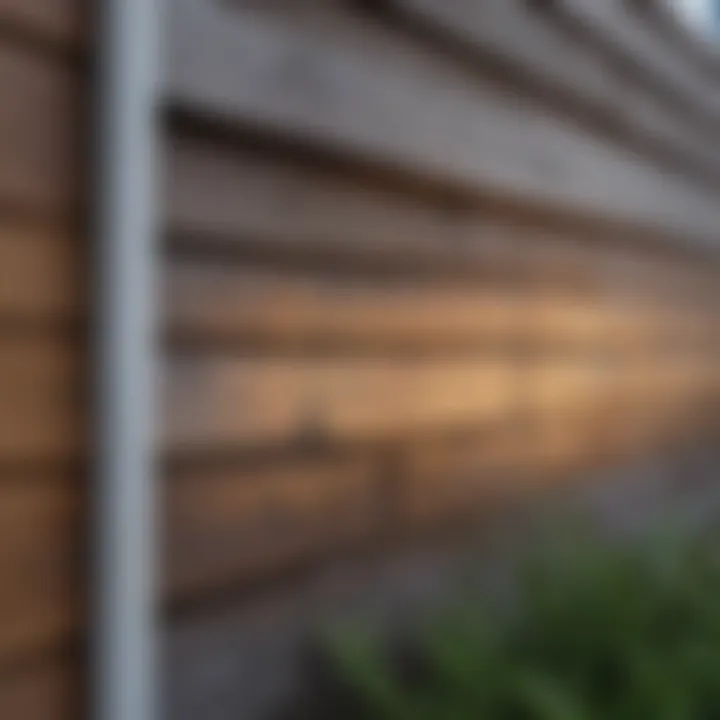
Understanding the post-painting considerations is critical for ensuring the durability and aesthetic appeal of your vinyl siding. After completing the painting process, the focus shifts towards maintaining the painted surface and preventing potential problems. This phase not only emphasizes the importance of upkeep but also addresses challenges that may arise in the long term. Paying attention to these aspects can significantly extend the life of your paint job and keep the vinyl siding looking fresh and vibrant.
Maintaining the Painted Surface
Once the paint has dried, maintaining the painted surface becomes essential. Regular cleaning is a key practice here. Use a soft cloth or sponge with a mild detergent to remove dirt and grime. Scrubbing too hard can damage the paint, so gentle techniques are recommended. It's also beneficial to rinse the surface thoroughly to prevent any soap residue from building up.
Additionally, inspect the surface periodically for any signs of deterioration. This includes looking for peeling, bubbling, or fading paint. Addressing these concerns early on can prevent further damage and save costs on extensive repairs later.
Here are some best practices for maintaining your painted vinyl siding:
- Schedule routine inspections every six months.
- Clean the surface at least twice a year to remove environmental pollutants.
- Avoid aggressive cleaning methods, such as power washing, which can strip the paint.
- Touch up any small chips or scratches promptly to prevent moisture intrusion.
Identifying Potential Issues
Identifying potential issues after painting is another crucial task for homeowners. The painted surface is susceptible to various problems that can affect its appeal and durability. Some common issues include:
- Fading Colors
Over time, exposure to sunlight can fade the paint. Choosing high-quality paint with UV resistance can mitigate this issue. - Peeling and Chipping
This can result from improper surface preparation or using incompatible paint. Regular checks can help catch peeling early before it escalates. - Mold and Mildew Growth
Moisture accumulation on the surface can lead to mold. Use mold-resistant paint or treatments as preventive measures.
It's advisable to stay vigilant and address any emerging issues as they appear. Ignoring them could result in costly repairs and even necessitate repainting.
"The maintenance of your painted vinyl surface influences not just its appearance but also its longevity. Regular care is key to sustaining the investment of painting."
By focusing on these post-painting considerations, homeowners can ensure their vinyl siding remains beautiful and structurally sound for years to come.
Long-Term Effects of Painting Vinyl Siding
Understanding the long-term effects of painting vinyl siding is crucial for homeowners considering this project. Painting vinyl can significantly alter the exterior appearance and potentially enhance the value of a property. However, there are important factors to consider regarding durability and maintenance to ensure beneficial outcomes. The decisions made during and after the painting process can have lasting effects on both the siding itself and the home’s overall aesthetic.
Impact on Warranty and Lifespan
Most vinyl siding comes with a warranty that specifies how the product can be used and maintained. When homeowners choose to paint their vinyl siding, they might inadvertently void this warranty. Manufacturers often provide clear guidelines that do not include painting as a maintenance option. It is essential to consult the warranty terms before proceeding with painting, as failing to do so may eliminate protections covering defects and premature wear.
Moreover, the lifespan of painted vinyl siding can be different from that of unpainted siding. Simple exposure to elements can lead to additional wear. Unpainted vinyl typically requires less maintenance. In contrast, painted vinyl may need touch-ups or complete repainting within a few years due to peeling or fading. The application of paint might slow down the natural aging process of vinyl but does not prevent it. Therefore, homeowners should consider how long they expect the paint to last and the potential costs involved in ongoing maintenance.
Potential for Fading and Peeling
One of the most common issues after painting vinyl siding is the potential for fading and peeling. Paint, regardless of its quality, responds differently to UV exposure compared to the original vinyl surface. Most vinyl siding is designed to resist fading, while paint may not share these properties. As a result, colors may start to dull or shift in tone over time, affecting the overall look of the home.
Furthermore, peeling is another concern. The adhesion of paint to vinyl can be compromised by moisture trapped beneath the surface or application in unsuitable weather conditions. Regular inspections and maintenance such as cleaning the painted surface can help mitigate these issues, but they cannot eliminate them entirely. Over time, if the siding begins to peel, it can lead to additional damage to the underlying vinyl.
In summary, while painting vinyl siding can be an effective way to refresh the look of a home, it is not without its challenges. Homeowners should weigh the benefits against the potential drawbacks carefully. Understanding warranty implications, planning for lifespan, and anticipating maintenance needs can lead to a more informed decision about whether to proceed with painting.
"Consider the long-term impact of your decisions on your home’s exterior. A thorough understanding of potential issues is crucial to ensure satisfaction with the result."
This knowledge can guide homeowners in making choices that align with their aesthetic desires while protecting their investment.
The End
Painting vinyl siding is more than a simple aesthetic upgrade; it involves a careful consideration of various factors that can determine the outcome of the project. In this guide, we have explored the intricate details surrounding the feasibility of painting vinyl siding, shedding light on significant aspects such as preparation, paint selection, and maintenance.
Addressing the feasibility of painting vinyl siding is crucial for homeowners. Not only does it enhance the property’s appeal, but it also may be necessary for maintaining its exterior longevity. However, understanding the limitations and risks involved, such as warranty concerns and potential for damage, cannot be overlooked. Homeowners must weigh the benefits against the potential issues to make an informed decision.
Revisiting the Feasibility of Painting Vinyl Siding
When considering if painting vinyl siding is a viable option, it is essential to assess the current condition of the siding.
- Material Quality: High-quality vinyl designed for external use generally withstands the elements better than lower-quality options. Ensure your siding is in good shape before attempting any paint application.
- Manufacturer Recommendations: Some manufacturers explicitly state in their warranties that painting their products voids coverage. Always review warranty terms before proceeding.
- Aesthetic Changes: Painting can refresh the facade of the home, allowing for new colors or styles. Many homeowners find value in a visual upgrade that painting offers.
The decision ultimately requires a balanced approach that factors in these elements. Consider consulting with professionals or seeking out homeowner experiences, possibly from forums like Reddit for insights.
Final Thoughts on Best Practices
When embarking on the journey of painting vinyl siding, adherence to best practices is critical for ensuring a successful outcome. Here are some important practices to follow:
- Pre-Painting Preparation: Thoroughly clean and inspect the siding. Any negligence in this step can lead to uneven results or peeling.
- Use of Appropriate Paint: Select paint specifically formulated for vinyl siding. Avoid generic options that do not account for the unique properties of vinyl.
- Application Techniques: Familiarize yourself with proper application techniques, such as using a sprayer for an even finish and applying multiple thin coats.
Incorporating these best practices not only extends the life of the paint job but also contributes to the overall durability of the siding itself. A well-executed project can bring lasting satisfaction to homeowners, transforming the visual landscape of their homes.
"Preparation and execution are key to maximizing the benefits of painting vinyl siding."
By understanding and employing these practices, homeowners can enjoy a freshly painted exterior that enhances their home while ensuring long-term beauty and integrity.







